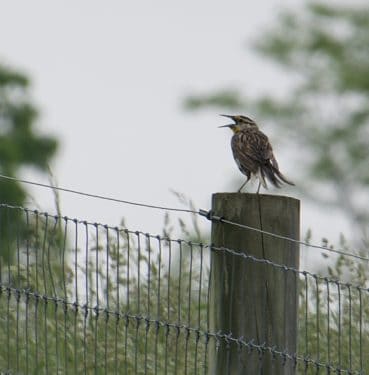bellwether birds.
Many have been inspired by the Bobolink’s melodic call. Describing the grassland bird, Thoreau wrote, “This flashing, tinkling meteor bursts through the expectant meadow air, leaving a train of tinkling notes behind.”

Bobolink at Stroud Preserve
Photo by Mike Niven
Natural Lands volunteer Jim McVoy knows the Bobolink well. Since 2003, he has spent many hours sitting cross-legged in the grassy meadows at our Stroud Preserve peering through his binoculars to observe Bobolinks and Eastern Meadowlarks. From April to early July he visits several preselected sites, initially to count nests (which both species prefer to make in tall, dense grasses) and then later in the season to assess fledglings. Over the years, we have used Jim’s research results to direct our mowing and grazing practices and to reconfigure land cover to help minimize threats to Bobolink and Meadowlark nests.
“When I was originally asked about the project, it was to be a one-time count and population assessment. I felt that, to gather any statistically useful information, I should monitor several sites over the entire nesting season and preferably for several successive years. I made more work for myself, but my records have demonstrated that the Bobolink nesting fields should be mowed at least a few weeks later than past practices to give the fledglings time to develop their independence. If my time in the field has accomplished even that little bit, it has been worth every minute.”
The Pennsylvania Game Commission reported that the state has lost 1.1 million acres of farmland in the past 40 years. Since that time, major declines have occurred in almost all groups of grassland-associated wildlife. According to the North American Breeding Bird Survey, the Bobolink population in the US declined by 65 percent between 1966 and 2015. Other grassland species, like Eastern Meadowlark, have seen an even more alarming decline.

Eastern Meadowlark at Stroud Preserve
Photo by Mike Niven
Birds, like frogs, are an environmental bellwether. Scientists have long used changes in bird populations, behavior, and reproductive ability to examine the effects of habitat fragmentation and invasive species, monitor water quality, and identify environmental pollutants. Because of their rapid metabolism and wide geographical range, they reflect changes in the environment quickly and warn us when things are out of balance. The documented observations of volunteer birders like Jim McVoy provide valuable data about bird populations over a broad geographical range.
Ultimately, it is Jim’s love of the birds—and, by extension, their grass-land habitat—that drives his volunteer efforts on their behalf. “Every spring the Bobolinks’ arrival at Stroud is a moment of wonder for me. I know that some of these birds were here the previous summer and have flown to their South American wintering grounds and back. The thrill of witnessing their return after crossing two continents is one I want to be able to share with my grandchildren. I’m just doing what I can to help ensure their survival so I can do just that.”
Please note: the field where Bobolinks and other grassland species mate is closed to the public from April through August to avoid disturbing these birds. Check out our events calendar for exclusive events that offer access and information next spring.
